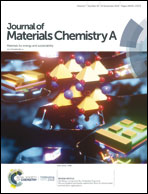Redox potential regulation toward suppressing hydrogen evolution in aqueous sodium-ion batteries: Na1.5Ti1.5Fe0.5(PO4)3†
Abstract
Aqueous sodium-ion batteries (ASIBs) show superior characteristics with high safety and low cost for large scale energy storage systems. However, easily occurring hydrogen evolution at a negative potential is a huge barrier to the application of anode materials in ASIBs. Even the most promising insert-type anode material, NaTi2(PO4)3 (NTP), cannot be commercialized due to its inadequate operating potential (−0.807 V vs. Ag/AgCl) that is close to the hydrogen evolution potential (−0.817 V vs. Ag/AgCl). Here, we report a redox potential regulation strategy to overcome this technical problem by integrating the redox couples of Ti4+/Ti3+ and Fe3+/Fe2+ to yield Na1.5Ti1.5Fe0.5(PO4)3 (NTFP) and increasing its operating potential up to −0.721 V vs. Ag/AgCl, which effectively prevents the potential overlap with the reductive decomposition of H2O. Importantly, the excellent electrochemical properties and low energy consuming synthetic route to NTFP open a new perspective to energetically develop low cost and highly stable ASIBs as a large-scale energy storage tool.



 Please wait while we load your content...
Please wait while we load your content...